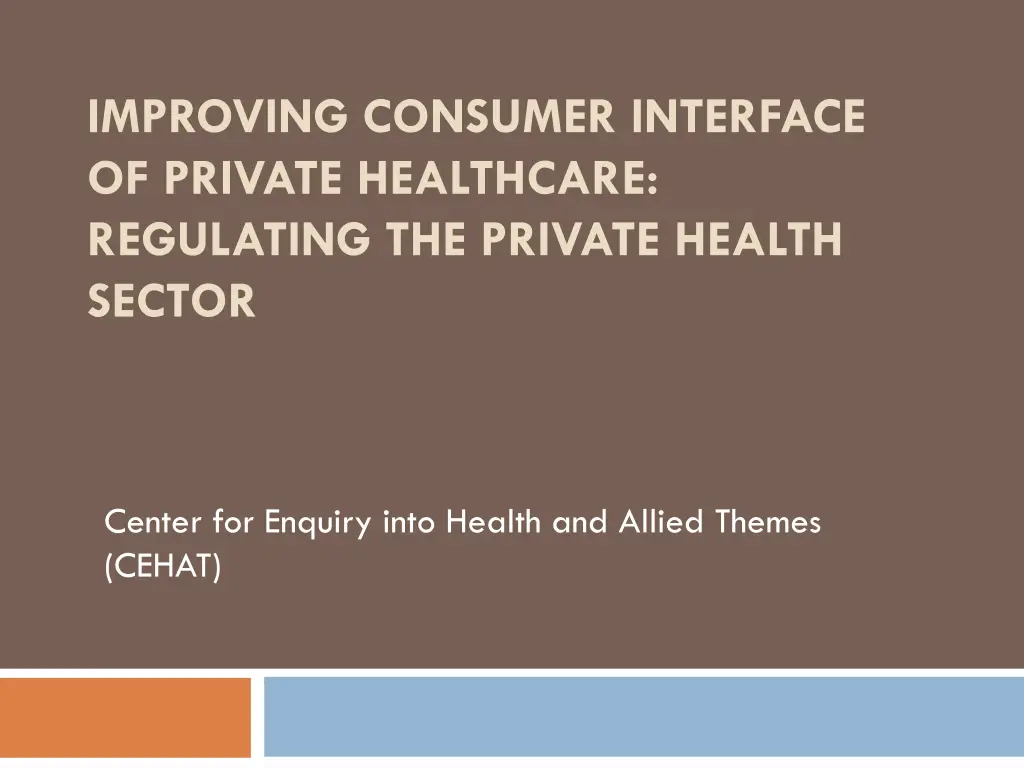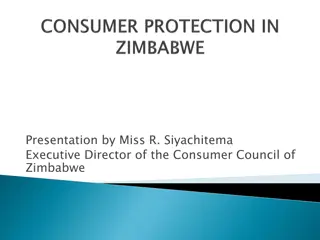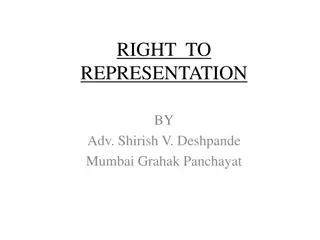
Regulating the Private Health Sector to Improve Consumer Interface
Addressing the growing dominance of the private health sector in India, this research explores the challenges and opportunities for enhancing consumer interaction and regulating private healthcare services. It delves into the shift from public to private health expenditure, highlighting trends in hospitalization, care shares, and characteristics of the private health sector.
Download Presentation

Please find below an Image/Link to download the presentation.
The content on the website is provided AS IS for your information and personal use only. It may not be sold, licensed, or shared on other websites without obtaining consent from the author. If you encounter any issues during the download, it is possible that the publisher has removed the file from their server.
You are allowed to download the files provided on this website for personal or commercial use, subject to the condition that they are used lawfully. All files are the property of their respective owners.
The content on the website is provided AS IS for your information and personal use only. It may not be sold, licensed, or shared on other websites without obtaining consent from the author.
E N D
Presentation Transcript
IMPROVING CONSUMER INTERFACE OF PRIVATE HEALTHCARE: REGULATING THE PRIVATE HEALTH SECTOR Center for Enquiry into Health and Allied Themes (CEHAT)
Growth of the Private Health Sector in India In 1947, the private health sector provided only 5-10 per cent of total patient care (Sengupta 2005) but in 2004 it is 78 per cent in the rural areas and 81 per cent in the urban areas (MoHFW 2007). India s public spending on health, after increasing between 1950 51 and 1985 86, stagnated during 1995 2005.It was down to 0 95 per cent of the GDP in 2005. In 2004 05, government expenditure (including external support) accounted for 22 per cent of total health and private spending in 2004 05 accounted for 78 per cent of the total spending on health (Shivakumar 2011).
Public health expenditures across countries Total Health Expenditure as % of GDP 5.2 2.7 3.0 2.4 6.7 Public health expenditure as % of total 17.2 24.9 45.4 57.6 37.8 U-5 Life Expectancy Male Female 59.6 68.1 65.8 67.6 69.2 mortality 95 43 19 14 14 61.2 71.3 73.4 69.9 76.3 India China Sri Lanka Malaysia Korea
SHARE OF HEALTH EXPENDITURE Public-Centre 3% Private Investment/ Insurance 2% Public-States 10% Private Out-of- pocket 85%
Trends in Hospitalisation Hospitalsation Cases: Govt/ Private (Percentage) NSSO Rounds Rural Urban Govt Private Govt Private 42nd 59.7 40.3 60.3 39.7 (86-87) 52nd 43.8 56.2 43.1 56.9 (95-96) 60th 41.7 58.3 38.2 61.8 Source: (MoFHW 2007 NSSO) (2004)
Public-Private Share of Care Immunizations Antenatal Care Institutional Deliveries Hospitalization Outpatient Care 0% 10% 20% 30% 40% 50% 60% 70% 80% 90% 100 % Public-Private Sector Shares Private Public
Characteristics Of The Private Health Sector Problem with Data Availability Qualified/Registered and Unqualified Practitioners Multiple Systems and Cross-practice Rural Urban Divide Poor Registration and Standards of Private Hospitals Focus on curative care Unregulated Practice No price regulation Demand increases with increased supply Price escalates with increased supply System of kickbacks/cut practice Professional bodies unconcerned
Why Regulate? Regulation aims at improving clinical performance (safety and quality) Regulation targets risk mitigation Regulation promotes ethics and social justice Regulation to protect professional standards
What is Regulation? Voluntarism- is based on an individual or organisational undertaking to do the right thing without coercion. Self-regulation- is where an organised group regulates the behaviour of its members (e.g. by establishing an industry- level code of practice). Economic instruments- involve supply-side funding sanctions or incentives for health care providers, and also demand- side measures that give more power to consumers. Meta-regulation- involves an external regulatory body ensuring that health care providers implement safety and quality programs and practices. Command and control- involves enforcement by government (e.g. ensuring compliance with rules for licensing facilities). Source: Braithwaite, J., Healy, J., Dwan, K.,(2005) The Governance of Health Safety and Quality, Commonwealth of Australia
Who should Regulate? Profession Independent agency Government Legislation Ethical codes Insurance Market
What to Regulate? Clinical practice Quality and standards Protocols Economics Ethics Legal dimensions
Regulating the Health Sector MACRO ASPECTS MICRO ASPECTS MACRO ASPECTS MICRO ASPECTS Fiscal Measures Audit of Medical Practice Fiscal Measures Audit of Medical Practice Legal Measures Setting of Minimum Standards Legal Measures Setting of Minimum Standards Social Audit Professional Measures Social Audit
Micro Aspects Audit of Medical Practice Minimum Standards Social Audit Consumer activisim Prescription and Diagnostics Audit Quality Norms Qualification Local body control Patient Records Minimum Equipment Filing Data Returns Accountability and responsibility Standard Charges Bills and Receipts Accreditation
Global Experience From professional ethics to legislation The insurance route Examples UK Healthcare Commission USA National Quality Forum Canada Patient Safety Institute Australia National Council for Safety and Quality in Healthcare
Indian Experience Unorganised healthcare system Supply induced demand Poor ethics Segmented legislation fire fighting approach Poor accountability, even with existing legislation Dilemma of profession versus business
Existing Regulation Medical Council of India and State Councils Local bodies Food and Drug Administration (FDA) Clinical Establishments Act (CEA) National Accreditation Board for Hospitals and HCPs (NABH) Indian Public Health Standards (IPHS)
Legislation Only 8 states have any legislation to regulate private health sector MP legislation for regulating nursing homes introduced as early as 1973, rules framed only in 1992 Bombay Nursing Home Regulation Act passed in 1949, not implemented PIL in 90s by the medicofriend circle and others - in 2006, extended to all of Maharashtra Clinical Establishments Act 2010 strong opposition in several states Even in states that have acts and where rules are implemented, no action against providers who didn t register
Evidence from the field A survey of 261 private hospitals (less than 30 beds) in 11 districts of Maharashtra found that: Most hospitals did not fulfill the minimum requirements under BNHRA 56 per cent of the hospitals under study did not have a single qualified nurse, more than 50 per cent hospitals did not have a resident doctor (24/7) only 14 of 114 maternity homes had a midwife. While the registration under the BNHRA was high (89 per cent), basic minimum requirements under the law such as display of certification, presence of qualified doctor and nurse, maintenance of case records were not complied with by most hospitals. Source: CEHAT, 2010
Patient Welfare issues in Pvt Health care Irrational use of drugs, over prescription, unnecessary diagnostics Rural, tribal, poorest most exposed to over use of injections No standard treatment protocols Nexus between doctors and the drug industry Cut Practice No Grievance Redressal Mechanisms Lack of information provided by health care providers
Public Private Partnerships There are several problems with the PPPs in health formed by the government with the private sector. The contracts between the public and private sectors have been found to be skewed in favour of the private sector. There is also hardly any evidence indicating whether or how these partnerships are increasing access to services, affecting out-of-pocket payments by patients, reducing or increasing equity or improving quality of care. Source: National Conference Report. Emerging health care models: engaging the private sector. Mumbai, 25 26 September 2009. At: <www.cehat.org/go/ uploads/PPP/reportfinal.pdf>.
Problems with PPPs No evidence that either quality of care or access increases with PPPs, nor that out-of-pocket payments reduce Only take safe cases shifting problem defeats the purpose Low motivation of implementers Maharashtra experience reluctant to get enrolled to provide EmOC Unnecessary procedures often harmful Arogyashri hysterectomy cases among 25-40 yr old women increased by 20% since its introduction!
Problems with PPPs Problems in Contracts No clear deliverables No clear accountability No clear planning for management No requisite standards for private partner No clauses for exit or penalty No STPs No grievance redressal mechanism No transparency in MoUs
The Case of Charitable Hospitals The charitable trust hospitals like Jaslok, Breach Candy, Bombay Hospital, Liavati, Hinduja, Nanavati, and Kokilaben Hospitals registered under the Public Trust Act receive tax waiver benefits and several other benefits like concessional land or a cheap lease rent, extra floor space index (FSI), concessional electricity, water or property tax, waivers or concessions for other taxes like octroi, customs duty, etc. They have an obligation to provide 10% of their beds for the indigent and an additional 10% beds for economically weaker sections, which they are not fulfilling. A CEHAT study found that most of these hospitals are not complying with this at all.
Some recommendations of the HLEG Establish a National Health Regulatory and Development Authority (NHRDA) Mandate the Accreditation of all HCPs Establish a system to independently evaluate performance Establish a Health System portal to strengthen use of IT Strengthen the Drugs and Medical Devices Regulatory Authority Engage Pvt sector for provision of healthcare through a well-defined ontracting n mechanism. BUT with reduced spending on public health, how are public health facilities expected to compete?
So where do we go from here? A comprehensive umberella Act National Health Act Developing a strategy for pooling financial resources deployed in health sector and redistribution based on existing resources Allocation of health budgets as block funding, on per capita basis redistribution of current expenditures Contracting-in of private providers, but with proper accountability and within public health goals. Compulsory public service by medical graduates increase resources in public health system substantially
Essential drugs to be brought back under price control. Location policies Medical councils to ensure only licensed practitioners practice Strict implementation of existing laws Strengthen health information systems so as to facilitate better planning, audit and accountability.
References DhawanRiya et al (2009) Contract Management in Emerging health care models: Engaging the private health sector National Conference held during 25th 26th September 2009, Mumbai. The conference report provides a very useful review of various PPP schemes. It can be accessed at http://www.cehat.org/go/uploads/PPP/reportfinal.pdf AkashAcharya and Paul McNamee, (2009) Can Public Private Partnership reduce Maternal Mortality? Assessing efforts made by the Chiranjeevi scheme in Gujarat , PPP Conference, CEHAT Mumbai. Moyna (2010) Menopaused 20-somethings , Down to Earth, at http://old.downtoearth.org.in/full.asp?foldername=20100615&filename=news&sid=5 Moyna (2010) Menopaused 20-somethings , Down to Earth, at http://old.downtoearth.org.in/full.asp?foldername=20100615&filename=news&sid=5 also see , http://timesofindia.indiatimes.com/india/The-uterus-snatchers-of-Andhra- /articleshow/6239344.cms http://www.hindu.com/2010/01/26/stories/2010012653230400.htm Public-Private partnerships in India: A case for reform? Economic & political weekly, August 2009 TK Sundari Ravindran (2011) Public-private interactions in reproductive health services in India: A mapping, CEHAT, Mumbai. Public Private Partnerships for Emergency Obstetric Care: Lessons from Maharashtra, Indian Journal of Community medicine, Jan-March 2011 http://www.ncbi.nlm.nih.gov/pmc /articles/PMC3104703/
Patients Rights Charter To what extent does this charter address the problems in the private sector? What does it not address? How would you implement this in your setting? What challenges do you foresee?
Sana Contractor sana@cehat.org






















